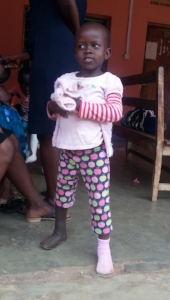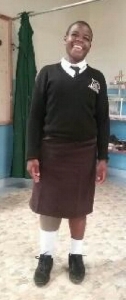By Joyce Coronel
In the waning days of October, a group of eighth-grade girls sat in a circle on the floor at Kyrene Middle School, their legs stretched out in front of them. Feet arrayed in colorful socks, they giggled as they waited for Wrangler News to arrive and tell the story of “Socktober.”
Yes, Socktober. You mean you haven’t heard of it? If 13-year-old Janelle Sneed has her way, the entire global community will soon be celebrating the hosiery-fueled campaign.
That’s because these KMS students are partnering with We Help Two, a non-profit that works with schools to raise money to purchase prosthetics for needy children in developing nations. For each pair of socks purchased, the buyer also receives a pair of socks to give to a homeless person.
“The best part is helping people,” Janelle said. “I’m going to buy them for my whole family and give them away at Christmas.” She’s also dreaming up an Instagram page and plotting for a trending hashtag dubbed #KMSSocktober.
“Social media is such a big thing these days, everyone’s there so we can get it global and help so many more people,” Janelle said.
Then there’s the dance fundraiser—a sock-hop of sorts—that will raise even more funds for the compassion-building project.
KMS, in the midst of its first year introducing the International Baccalaureate program, launched Socktober to helps students learn to think about the broader global community—a feature of the IB program—and serving others.
Kathie Cigich, IB Middle Year Program coordinator for KMS, said she snagged Socktober at a conference. Trevor Bergman, founder of We Help Two, was on hand to explain how his project fits in with the Learner Profile Attributes—an IB term that stands for the traits and characteristics educators work to develop in students. Caring is one of them.
Megan Haggerty, 14, was clearly touched by the message of reaching across the globe and caring about others. The gift of a prosthetic limb could be life-changing for one of her peers in Africa, she said.
“I think it’s going to give them a second chance at life,” Megan said. The students learned of a young girl named Patricia who was unable to attend school because she didn’t have a prosthetic leg.
“She couldn’t go to school because she couldn’t walk around. But since she was in this program, she was able to get a limb and now she’s in school.”
Cigich said that at the beginning a few KMS students wondered why the school would have a program to help children in far-flung Africa when there are needy students in Arizona.
“We’re more fortunate in America. We always have clean water, we have roads, we have hospitals,” Cigich said. In developing nations, that is frequently not the case. The We Help Two website features the stories of several children in Uganda, where the life expectancy is only 55 and the child mortality rate is the highest in East Africa. With high rates of poverty and one of the worst health care systems in the world, children born without limbs or who lose limbs through violence or trauma are caught in a downward spiral. KMS students are working to alleviate some of the suffering.
“We do take for granted what we have, I think. Doing things like this really opens our eyes,” Janelle said.
“It’s easy to forget about people that don’t have it as good as we do. We caught up in our lives. Thinking about other people in that situation—shoot, it makes me want to cry.”
Cigich has high hopes that Socktober’s lessons will be similarly impactful for other students.
The IB program helps them to be “open-minded and empathetic, teaching them that there is a whole world out there other than just your local community,” Cigich said.
Now for the math lesson: Each package of socks includes three pairs and sells for $12. For every 80 packages of socks sold, We Help Two can purchase an above-the-knee prosthetic limb for a child. According to the organization’s founder, the most common cause of amputations for students is violence, but some of the children were born without a full leg.
The online campaign at KMS began Oct. 18 and continues through November 29. So far, the effort has sold 54 packages of socks. The goal is 160.
Turning to the students, Cigich impressed upon them the far-reaching effects of the action one man took to help others.
“Trevor, the founder of We Help Two, is one person,” Cigich said. “It’s not a big company, it’s not a giant non-profit. We always say, ‘What can I do? I’m just one person.’ Well, the founder of We Help Two is one person that is changing these kids’ lives in Africa.”
Information: kyrene.org/kyr


